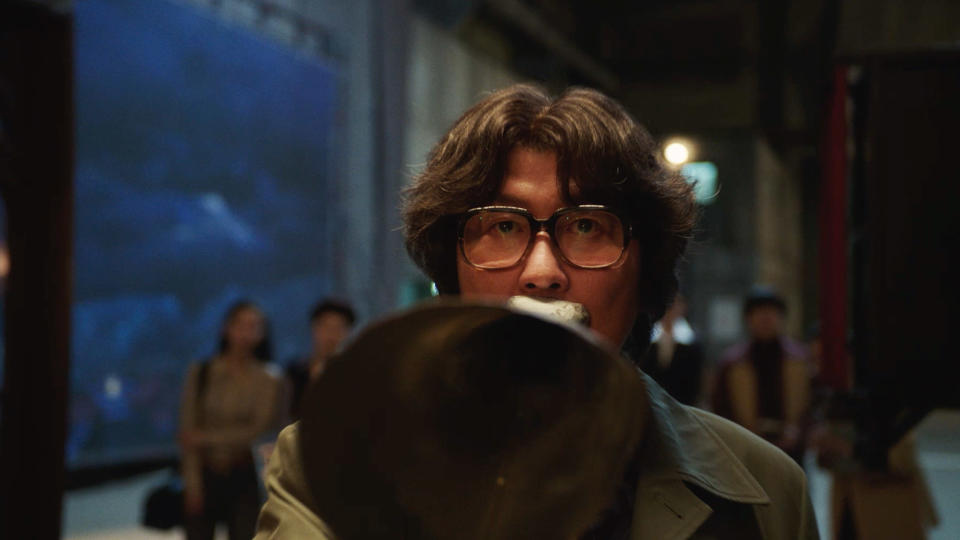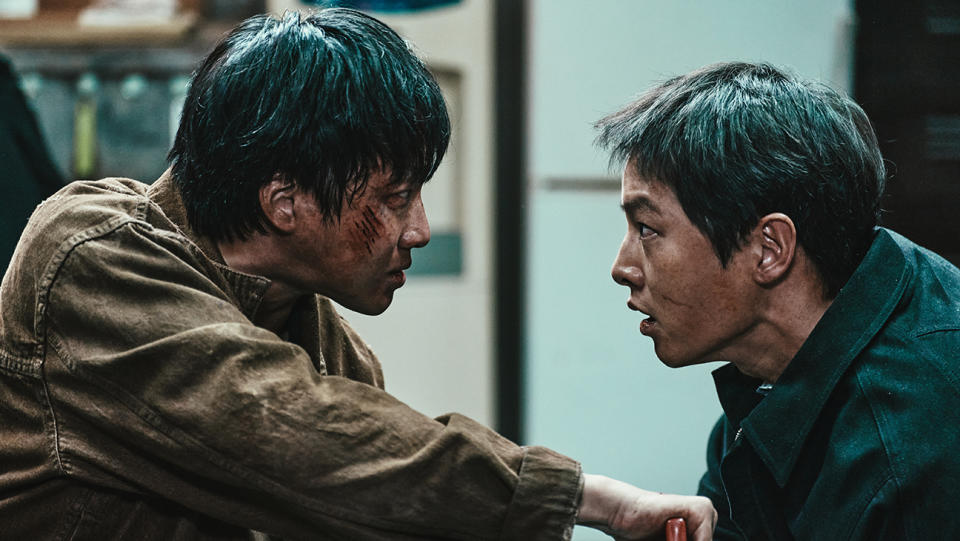Cannes: Plus M Entertainment CEO on Turning the Family Firm Into a Korean Content Powerhouse

South Korean executive Jeongin Hong never planned to become a movie mogul. After studying economics at Princeton and putting in distinguished stints in private equity at Boston Consulting and Goldman Sachs (“I’m a science and economics guy,” he says), he was lured back to the family business in 2015. His family’s firm happens to be JoongAng Group, arguably Korea’s largest media conglomerate. Founded by Hong’s grandfather, Hong Jin-ki, the company publishes Korea’s most widely read newspapers, owns a university and a skyscraper, and controls major broadcaster JTBC, among many other business lines. Hong was initially pulled back into the patrilineal corporate fold to help with corporate strategy; but in 2017 he proposed to his elder brother, JoongAng Group’s current CEO, Jeongdo Hong, that the time was right to further capitalize on the Korean content wave still sweeping the globe by restructuring their conglomerate’s collection of entertainment entities and scaling up to become a fully integrated film and TV studio. Among the business units placed under the junior Hong’s purview are Megabox, one of South Korea’s three largest multiplex chains; film financier and distributor Plus M Entertainment; and the fledging studio business, SLL (previously JTCB Studios).
Inspired by the Bob Iger and Kevin Mayer blueprint of assembling IP engines to drive future growth, Hong set off on a buying blitz to bolster SLL’s capacity. SLL now contains 16 different development and production companies (and has minority stakes in eight others), and collectively the unit is Netflix’s largest source for K-drama series in Korea. In 2021, Hong added a U.S. indie studio to the stable, acquiring CAA’s content division wiip (following the Writers Guild of America settlement that required agencies to divest such holdings).
More from The Hollywood Reporter
Hong also has aggressively expanded the ambitions of Plus M. The company was responsible for Korea’s biggest box-office hit in 2022, action star Don Lee’s The Roundup ($102.8 million), and it produced the directorial debut of Squid Game star Lee Jung-jae, The Hunt, which premiered out of competition at Cannes last May. Hong returns to the Croisette this year with a pair of feature’s representing the established and emerging of Korean cinema: period romp Cobweb, directed by Kim Jee-woon and starring Song Kang-ho, premiering out of competition; and first-time director Kim Chang-hoon’s mob drama Hopeless. Plus M also has a trio of buzzy market titles to debut in Cannes: Hope, the first international co-production from cult director Na Hong-jin (The Wailing), starring Alicia Vikander and Michael Fassbender; romance movie Love in the Big City; and drug world thriller Ya-Dang: The Triangular Connection.
The Hollywood Reporter connected with Hong ahead of Cannes to discuss why investing in art-house films is good longterm business, his views on Korea’s struggling post-pandemic theatrical landscape, and why he’s just getting started at making the family firm into a global entertainment power player.
Could you estimate how much your companies are spending on original film and TV content this year and how does that compare to several years ago, during the early stages of the transformation you have overseen since you joined the family business in 2017?
I’ll probably explain it to you this way. So in Korea, I would say there are somewhere between 170 to 180 K-drama series produced each year. Last year, we created around 32 of those series and this year our mission is to create 35. That’s around 20 percent of the scripted series made annually in Korea. If you go to the feature film side and subtract all of the independent movies and only focus on the commercial titles, normally there are around 70 to 80 commercial films released per year. Plus M Entertainment is investing and distributing in around 6 to 8 features per year, and then all of the production companies under SLL produce another 5-6 features a year. So adding them up, that’s around 15 features a year, which is again about 20 percent of local features released theatrically each year in Korea. That’s our current snapshot and we’re trying to become bigger. CJ Group and Studio Dragon probably do a few more films, but on the scripted side, our series output is pretty similar. Together, we probably manage about 45 percent of the total film and TV market in Korea. When I joined in 2017, and then really got started in 2018, our companies probably produced around eight scripted series per year and three or four niche, low-budget movies.

And what are your targets for growth going forward?
It’s our ambition to become bigger, but in the near-term future, we will be focussing more on boosting the size and quality of our productions. In terms of quantity, we’re one of the market’s dominant players in scripted series. We’re the biggest partner for Netflix in Korea and we’re the first partner for Disney+ when they launched. In feature film, I think we’re still in the transition period. Previously we were known for smaller-budget, meaningful art house movies, but under my leadership, we’ve decided to make more of a major commercial studio play. That’s where I think the new opportunities are. And I’m committed to film. The Korean wave has been going for some time, and it was Korean movies that first generated attention across the world. Now, series and streamers are making a lot of money, but it’s my belief that to keep sustaining Korean entertainment we need to continue to invest in film, because that’s where a lot of the great talent comes from. Movies have their own power, and that’s where the entertainment industry’s creativity often starts. So that’s why we started to do major-budget films in Korea. A good example was Hunt from last year, directed by Squid Game star Lee Jung-jae as his directorial debut. It had a budget of $20 million, which is pretty big in Korea. A lot of people were surprised, because Plus M wasn’t previously known for doing big films like that, and he was a first-time director, despite being a big star for decades. But it went well for us. We made our debut in Cannes with that title last year and it was a great start for us.
How are you structuring your film slates as you look to continue expanding your output?
Our ambition for M Plus Entertainment is to retain a position as one of the top two or three film studios in Korea, and to do that, we need some big-budget tentpole films every year, as well as a handful of mid-cap commercial movies. And then my goal is to continue doing a lot of smaller-budget but meaningful and artistic projects, so that we can support new creatives as they try to bring their dreams to screen. I think this is actually the most important part, long-term — especially because CJ has kind of stopped investing in these titles for a while. If we’re taking 20 percent of the market, our key success factors are fully aligned with the size and health of the Korean entertainment industry as a whole. In order for our slice to become bigger, we have to grow the whole market, basically. So I feel deeply obligated to support new young directors working in film, because if we just reap the rewards of established talent and force all of the emerging directors to work in series, or YouTube or other social video channels, where is that going to leave the professional Korean film business in 10 years?

And how about on the international side? How do projects like Na Hong Jin’s Hope fit into your strategy?
This will be a big one for us. Director Na is one of the most original filmmakers in Korea and he totally knows what he’s doing. He’s working with the same crew as he did on The Wailing, which are some of the most talented craftspeople in our industry. And it has a really exciting international cast. Hwang Jung-min — if you ask me, the biggest Korean actor other than Song Kang-ho — stars alongside Squid Game’s Jung Ho-Yeon. And from Hollywood, we have Alicia Vikander and Michael Fassbender. It has a very big budget for our industry and we’re financing it exclusively — it’s almost impossible to even break even from the Korean market alone with this one — so it’s a very big bet for us. But we as a company can learn and grow so much from doing it. We’re having discussions with different studios about bringing on an international partner, because it would be very helpful to have a powerful international partner to help us really get this film out into the world and have the IP become known. So, we’ll see how this first attempt goes.
Can you share more on the strategy behind your acquisition of Wiip from CAA? The Korean wave is already riding so high, and you already have such a strong business of servicing the U.S. streaming giants with your series and film content, why did you feel the need to take the risk of going global by acquiring a U.S. content producer?
As I said earlier, we already have a 20 percent market share and no one company in the content business can get to 50 percent — even Disney. It happens in the big tech but not in the content business. So I’ve always thought we need to grow the whole pie of the Korean industry, or we need to go global to find another growth engine. And very honestly, the U.S. market was not initially on my radar, because I’ve studied all of the stories from the past of the Asian companies that brought big money to Hollywood and lost a lot of it — the Japanese companies a few decades ago, and the Chinese companies in the past ten years or so.
So my primary international focus is actually Japan. I know they have great stories, great potential and a big domestic market. Consumers there still rent DVDs, so we know they are willing to pay for content. But the quality of their existing drama series productions doesn’t meet the quality and size of their market. There’s an opportunity there. So, we’ve been trying to set up another studio business mimicking SLL, but in Japan. We were slowed down a lot during the pandemic, but this year we are going to officially launch our Japan studio business. We’re also very bullish on Southeast Asia, because their youthful audiences there are huge fans of Korean dramas and movies. So, our plan there is to do the IP business, producing remakes and localized productions of our IP that has been proven in the region.
And the vision for Wiip?
When we were first invited to make an investment in Wiip, it was around 2019 and it was still a growth round. At the start, we only bought in to become about a 1 percent owner. I just wanted to get a view on what’s going on in Hollywood, how the global streamers are working, and what the trends are. So, it was just probing the market. But the fight between the writer’s guild and the agencies gave us the opportunity to actually enter the market. I don’t believe in manmade synergies, so, after the deal, I didn’t just force our producers to work with them. But it’s now the two-year anniversary of our acquisition of the company, and organic synergies are starting to emerge. Anthology Studios, our label that’s the co-producer of Cobweb, is trying to do a deal with Wiip to do co-productions. Hope has set an example for our companies too. I recently connected another one of our Korean producers with Wiip to codevelop something that could be a co-production. Traditionally, there have not been very good linkages between Korea and Hollywood, so there is a lot of potential. And Wiip is still very well connected to CAA, so they can help us package. So anything that could potentially work with Wiip, I’m super supportive of these days.
Since you’re also heading up Megabox, Korea’s third-biggest cinema chain, I’m curious to hear your thoughts on the state of the Korean theatrical market right now. From a distance, it’s kind of surprising how slow the Korean box office has been to recover, because pre-pandemic, Korea famously had one of the highest rates of moviegoing per capita in the world, and this had always been cited as an integral part of the industry’s phenomenal growth story in recent decades — the way the local movie audience was developed and sustained. How do you read the market now?
I think the biggest reason for the slow comeback of the Korean film audience is probably that local content was very strong, pre-pandemic — which is pretty ironic. 2019 was a record-setting year for our box office. Both domestic films and Hollywood titles — especially Disney’s Marvel tentpoles — were doing phenomenally well. But Korean movies have a sort of structural problem now. Korean movies always had a scale advantage versus other domestic content in the local landscape, and until recently Korean films were boosted by government support. The average budget for a movie in Korea is probably about $5 million, and up until 5-10 years ago, the average budget for a TV drama series was about $500,000. So, local TV didn’t offer much scale. Everyone says it’s the pandemic that has diminished our box office, but I think it’s more because of Netflix and the big local TV channels — like our JTBC, CJ ENM, and TBN included. First, drama series budgets creeped over $1 million per episode, and now it’s sometimes well over $3 million. We produced Narco-Saints for Netflix and that was $3.5 million per episode. And some are going even higher now. So, the Korean audience doesn’t need to come out to the cinema for Korean content at scale anymore. You can watch a $5 million per episode series on your 80-inch TV in the comfort of your own home — and the streamers are still hungry to make more of this stuff. In the past, because of the strict regulations governing TV in Korea, you couldn’t show someone smoking, no nudity, limited violence. So, people would go to the cinema to see scale and to see something different. Now, Netflix gives you all kinds of content from all over the world, much of produced at a significant budget. So, we need to raise the bar of our production ambitions with feature films. But because of COVID, many of the studios have a bunch of titles they are sitting on, and they’re experiencing a lot of cashflow constraints, so then when they do release them, they haven’t been doing it with very sharp marketing — and some of these titles are a few years old, so they are slightly behind trend and arguably under-budgeted in the current climate. So, all of this means we’re sort of stuck in a vicious cycle that’s going to take a little while to unwind. It’s going to take time to rebuild inventories and reset the bar, but I’m confident it will happen. Maybe not to 2019 box office levels overnight, but we’ll get to 90 percent. We just need to keep investing in ambitious filmmaking as an industry.
Best of The Hollywood Reporter